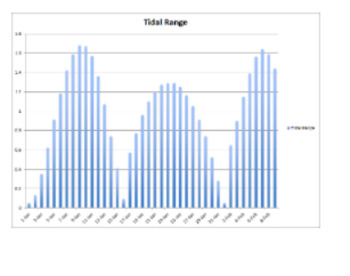


With the 18.613 year lunar nodal tidal cycle, that phase shift could be as much as ☙.31 years. Every place instead experiences a phase shift from when one would naively expect high tide to occur. Places do not in general experience high tide when the Moon is at zenith.

The amphidromic systems that result from tidal forcings result in rotating waves about amphidromic points. In yet other places, high tide happens when the Moon is halfway up in the sky. But it's the other way around in other places: High tide happens when the Moon is at the horizon. What about the fact that there is no lunar standstill in 2020? There are a few places experience the M 2 appears to be exactly in sync with the Moon in that high tide happens when the Moon is at zenith / underfoot, low tide when the Moon is at the horizon. Even more to the point, tide gauge records have shown that the 18.61 year period lunar nodal tidal cycle can change high water levels by up to 30 cm. More to the point, many places along the UK coastline experienced the highest tide for 18.6 years between the 19th and 30th of September. Miami, for example, experiences annual king tides that flood low-lying parts of the city. Moreover, the shape of continents and the depths of the oceans can make what are normally small tidal influences have locally magnified significance. Quiz 2: 5 questions Practice what you’ve learned, and level up on the above skills. That said, the very long frequency means that this generally small tide can add insult to injury when shorter frequency tides line up to create very high spring tides. Quiz 1: 6 questions Practice what you’ve learned, and level up on the above skills. Every tidal component results in its own set of amphidromic systems.) The 18.61 year period lunar nodal tidal cycle results in rather weak tides in general, typically less than a centimeter. (Note: The linked site discusses the response to the M 2 tidal component. The longest modeled term, the lunar nodal tidal cycle, has a period of 18.61 years.Įach of those exciting frequencies results in a set of amphidromic systems. There are many other components to the tides. This is due to the Moon, whose tidal influence is over twice that of the Sun. The dominant frequency in most places is the M 2 tidal component with a frequency of 12 hours and 25.2 minutes. The Moon and the Sun excite tides in the Earth's oceans at a variety of frequencies. There is no lunar standstill, major or minor, in 2020. The most recent minor lunar standstill was in 2015. The possibly "fake news" part first: The next major lunar standstill will be in late 2024 / early 2025. Possibly "fake news", but very possibly yes. Can a "Major Lunar Standstill" cause one-day high tides as described in the Jakarta article?


 0 kommentar(er)
0 kommentar(er)
